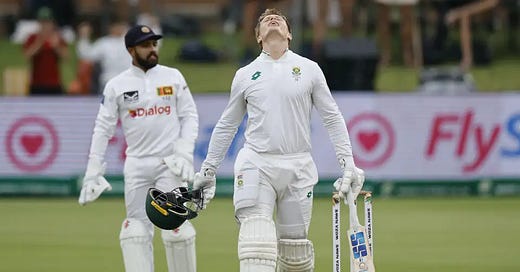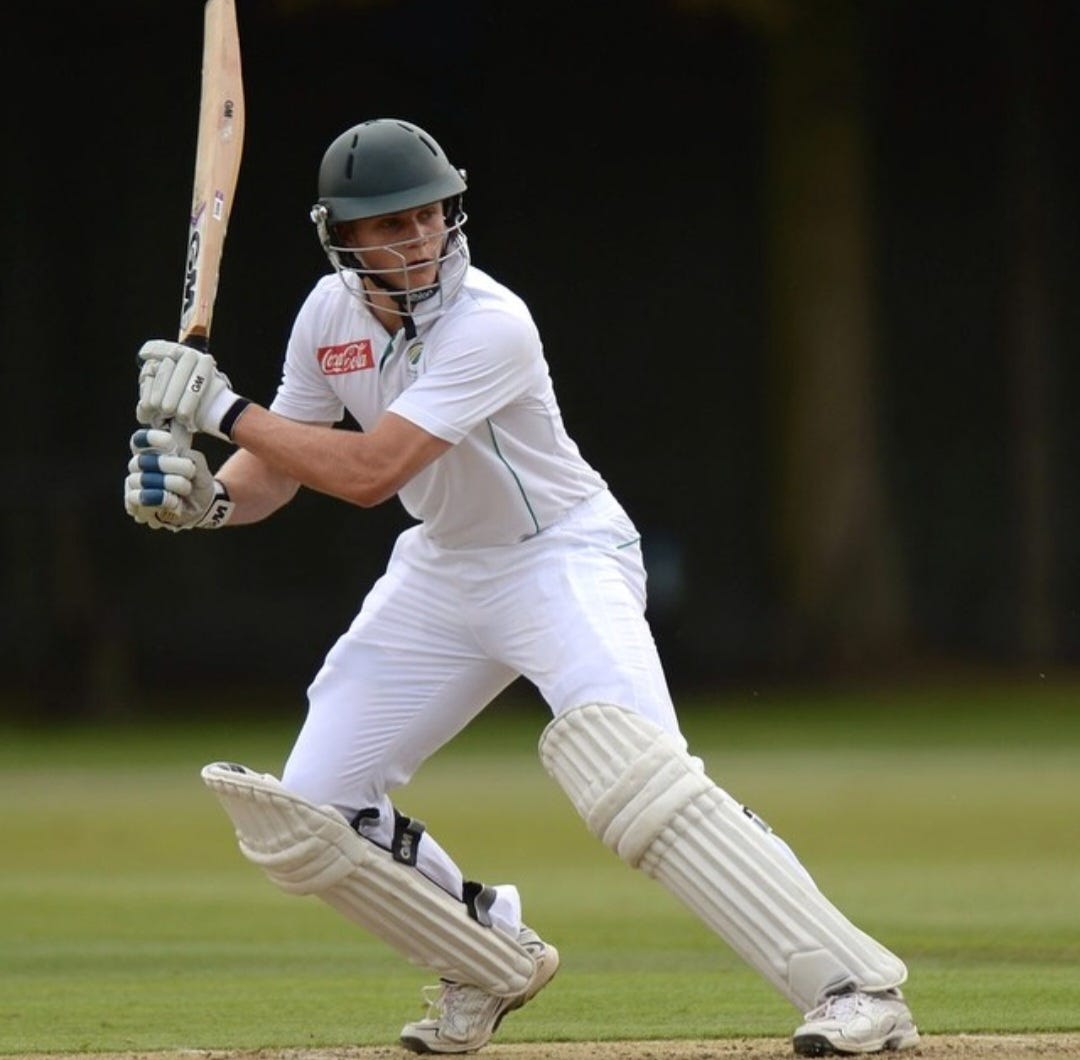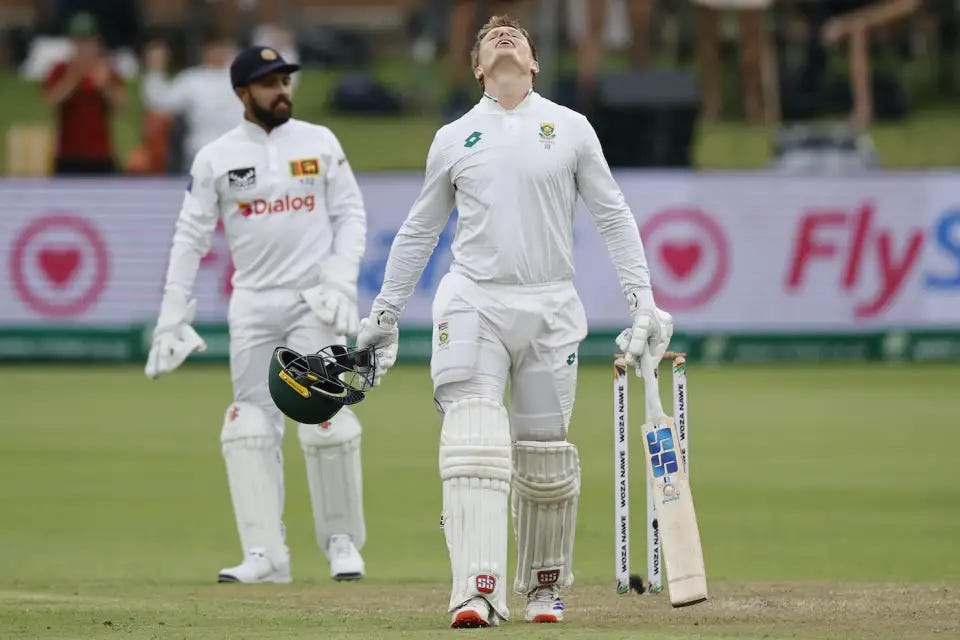What do batters discuss while waiting for the third umpire to go through the footage after a review? The first is probably why they think it's not out - didn't pitch in line, struck the batter outside the line of the stumps, too high or maybe an inside edge. Agree, nod, reassure. The conversation probably segues to dinner plans, upcoming sporting events, the crowd…
Whatever it is, that's what Ryan Rickelton and Kyle Verreynne were discussing as they stood in the middle of the pitch. The Sri Lanka team stood together, watching the big screen expectantly. Dhananjaya de Silva and his team had been trying to dislodge Rickelton for 67.2 overs, and now Vishwa Fernando had created an opportunity.
The left-arm pacer’s delivery had pitched on a length and nipped back. Rickelton went on the drive but missed and was struck on the pads. The umpire did not hesitate, he gave him out. Rickelton reviewed and now the wait was on. He has reached and passed the 50-run mark 33 times in first-class cricket. Rickelton converted 16 of those half-centuries into 100s for an outstanding conversion rate that is just under 50% (48.5).
Four of the 17 half-centuries he failed to convert to triple figures were scores in the 90s. They were for each team he has represented in red-ball cricket. He scored 98 for Gauteng Strikers in 2017, 92 for SA A, 90 and 95 for the Lions and Northamptonshire in 2022.
The only team missing from that list was the Proteas, and as Rickelton stood next to Kyle Verreynne, waiting for Umpire Sharfuddoula Saikat to decide, he wondered if this was his 90 score for South Africa.
Rickelton loved cricket balls, squash balls, soccer balls, and rugby balls. Throughout his school career, Ryan participated in all sports available at the schools he attended. All sports except swimming. Maybe because there were no balls involved in swimming. He only went into the pool when he had to.
The only ball-less activity he chose to participate in was weightlifting. Rickelton was an explorer. When he wasn’t hitting tennis balls hanging from a tree with a lightweight bat in the backyard, Rickelton explored the St Stithians grounds. One day he popped his head into the school gym and never left. He was fascinated.
Steve Kafang and Rodney Anthony, the strength and conditioning coaches, did not have the heart to turn the youngster away. Before long, Ryan was as much a part of the centre as Kafang and Anthony.
The coaches started him with an unweighted broomstick. The broomstick helped him to learn the movement patterns involved in Olympic weightlifting. From there he graduated to an unweighted metal rod. Over time, Kafang and Anthony slowly added resistance, added weight and changed the bars.
Rickelton enjoyed weightlifting so much that he got involved in provincial competitions at U9, U10, U11, U12, U13 and U14. He lifted 61kg to set a new Gauteng Under-14 weightlifting snatch record. The record would stand for the next few years. He had been weightlifting for about six years when he made history.
However, weightlifting was a side quest. His first love was cricket. He gave his all to it. When Ryan had his first net session, an adult bat was taller than him. Ian rolled the ball to him, underarm. Ian was teaching and coaching at St. John’s College at the time. When he faced the bowling machine for the first time, he was in batting pads handed down from Dean. They were junior-sized pads.
Ryan was around six or seven years old when he faced a bowling machine for the first time. Ian had just taken up a post as St. Stithians’ director of sports. Ryan had fallen in love with the machine long before he faced it for the first time. Being on the other end of the machine as Ian shot balls at him was heaven as far as Ryan was concerned. Ian adjusted the machine to suit Ryan’s age and ability as a youngster.
“I never said no to him,” Ian shared. “When I was free, if he asked me to go to the nets or to the bowling machine, we would go. He was driven, even as a youngster. Sometimes we would do three to 400 balls in a session. You know, even as a youngster, as a little guy, he just wanted to hit balls, so we just hit balls.”
A bag of 60 balls did not last long.
Ian taught Ryan the basics of batting. He did not want to rush the boy, so he stuck to the rudimentary aspects of foot movement, head and shoulder positions, and how to execute drives. When Ryan was around 12 or 13, Ian took Ryan to Trinity House to see Peter Stringer. When Peter Stringer took up a coaching post at St. Stithians later, Ryan would spend a lot of time with the Yorkshireman.
It was Stringer who developed Ryan Rickelton the batter that he grew up to be. Stringer is a Yorkshireman. A Yorkshire man from the same generation as Geoffrey Boycott. Stringer played with Boycott between 1967 and 1972. For Stringer and his generation, having a proper cricketing technique is important. You either do it right or you don’t do it at all.
Ian Rickelton knew Stringer from his schoolboy days. Peter Stringer had been his cricket coach. Stringer also coached Ian when he played for the Wanderers Club in the 1980s. He knew and trusted the former County cricketer’s methods.
“Peter Stringer challenged Ryan a lot,” Ian recalled. “He would challenge Ryan to face up to 300 balls without hitting a single aerial shot. He taught Ryan to value his wicket and pick his shots.”
Ian Rickelton and Peter Stringer often told Ryan about earning the right to score big runs. They felt that once a player reached 30 or 40, or 60, they had earned the right to reach a milestone.
“I always stressed to him the difference between getting yourself out versus bowlers getting you out,” Ian said.
The training that Ryan received from Peter Stringer was aimed at making him a Test cricketer. Stringer asked and expected Ryan to treat net sessions like a match. There was no time to fiddle around.
“Peter just helped me to build the foundation. In cricket, everyone has got all the shots and all the ideas but has lost the fundamentals. In the longer formats, it’s those who can keep it simple for longer and do the basics better than the opposition who come out on top,” Rickelton shared.
In 1882, Vincent van Gogh created a painting, watercolours on paper, which featured a group of people sitting in a dimly lit room, waiting. The composition centres around a window that illuminates the figures, casting long shadows that merge with the dark, muted tones of the surroundings. Van Gogh’s use of light and shadow, coupled with his sensitive portrayal of ordinary people, captures the essence of human patience and anticipation in a shared, quiet space.
Rickelton was one of Van Gogh’s waiting figures at various parts of his career. The Proteas have played 24 Tests from the time Rickelton has been in and around the team. He has only been part of eight matches. His journey with the side was a waiting game for a moment to open up. When the opportunities came, Rickelton had to bat at six.
Rickelton is a natural opener. He became an opener because when he shared with Ian that he wanted to play cricket professionally, Ian told him it’s better to be an opener than anything else. He followed his father’s advice. He scored his maiden first-class century opening the batting. It was in his third red ball match.
However, he had to learn to be a number three and four batter when he got to the Lions because the province had too many openers. Part of that transformation included hours of Rickelton studying Rassie van der Dussen’s approach to the game. When he moved from the Dragons, Van der Dussen was an opener and had to adapt his game to fit into the Lions’ set-up.
When he got to the Proteas, he didn’t just have to wait for an opportunity, he also had to wait for the right spot to open up. After seven matches batting in the middle order, he was offered an opportunity in his best position.
“Playing the new ball in red-ball cricket tightens me up. When I come in down the order I get too loose and expansive. Before the match, Shukri asked me if I wanted to bat at three. I jumped at the opportunity,” he shared.
And now, as the umpire looked at the footage, Rickelton had to wait, heart in his mouth. Everyone in the stadium was unsure, save for a young boy wearing a Proteas limited-overs shirt. The youngster had motioned that Rickelton needed to review the decision immediately. The boy was certain Rickelton was not out.
The big screen showed a spike when the ball was next to the bat. The camera panned back to the youngster and he was leading the celebrations. A relieved Ryan Rickelton went back to the crease and prepared to face the next delivery. It was a dot ball.
The final delivery of the over was on a length close to the off-stump. Rickelton fell back on his training from Peter Stringer and presented the full face of the bat to the ball, sending it back past the bowler. Rickelton and Kyle Verreynne ran two runs to complete his maiden Test century. Rickelton pumped his fists, removed his helmet and hugged Verreynne.
The waiting was over.






